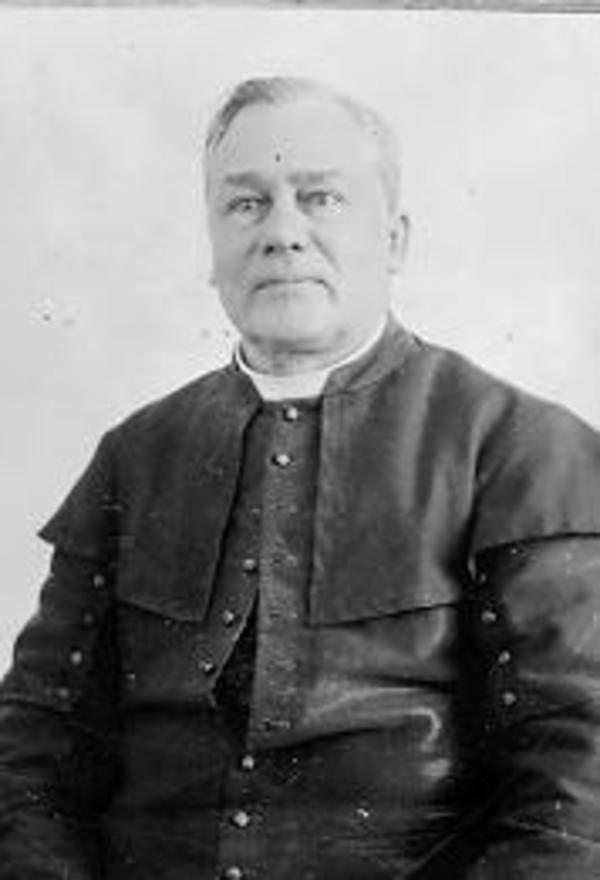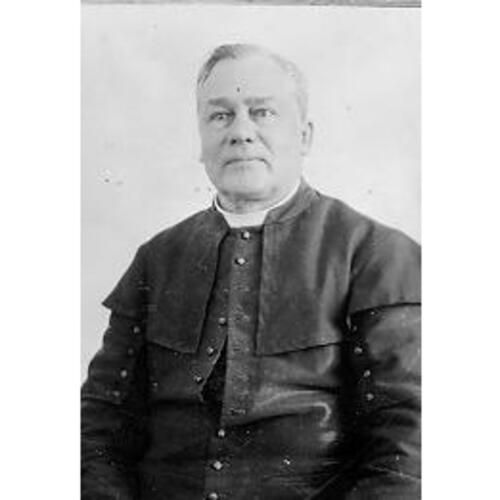
Source: Courtesy of Wikimedia Commons
DOUCET, STANISLAS-JOSEPH, priest, Acadian patriot, homeopath, inventor, and author; b. 8 July 1847 in Bathurst, N.B., only son of François-Xavier Doucet, a farmer, and Rachel Boudrot (Boudreau); d. 1 Dec. 1925 in Grande-Anse, N.B.
After his elementary schooling in Bathurst, Stanislas-Joseph Doucet studied at St Michael’s Academy in Chatham, and in September 1868 enrolled in the Grand Séminaire in Montreal. He was ordained to the priesthood for the diocese of Chatham on 31 July 1870 in Charlottetown. Since Bishop James Rogers* of Chatham was attending the first Vatican Council, which proclaimed papal infallibility, the ordination was conferred by the bishop of Charlottetown, Peter McIntyre*. Doucet was immediately appointed curate in Tracadie, N.B. In 1871 he became a curé, and he held this status for the rest of his life. He served at the following places: Shippagan, with responsibility for the islands of Lamèque and Miscou, in 1871–72; Saint-Charles, in Kent County, with responsibility for Richibucto, from 1872 to 1877; Pokemouche from 1877 to 1887; Shippagan from 1888 to 1898; and Grande-Anse from 1898 to 1925. In 1900 Rogers appointed him vicar general, a post he held until the bishop’s death in 1902. When Bishop Thomas Francis Barry of Chatham got him an appointment from Rome as domestic prelate in November 1916, Abbé Doucet assumed the title of monsignor. In 1920 Patrice-Alexandre Chiasson became the first Acadian bishop of Chatham and he also made Doucet vicar general.
Considered a great patriot by his contemporaries, Doucet was one of the moving spirits behind the “Acadian renaissance.” He played a prominent role at five of the Conventions Nationales des Acadiens held between 1881 and 1921, putting forward his ideas on the major topics of Acadian nationalism, including the choice of a date for a national holiday (1881) and of a flag (1884) [see Marcel-François Richard*]. At the meetings in 1905 he took stock of Acadian achievements in various fields. Three years later he was a member of the commission on relations between the Acadians of the Maritime provinces and those of the United States. In the 1921 convention he declared himself in favour of protecting historic sites (the fortress of Louisbourg and Fort Beauséjour).
Abbé Doucet had played an active role in founding the Courrier des provinces Maritimes in Bathurst in 1885. Subsequently, between 1890 and 1915, he used the press on many occasions to make known his views on important matters, such as the language question. He gave a lecture on this subject at the University of New Brunswick in Fredericton in 1896, and he published the text that year in Saint John under the title Dual language in Canada: its advantages and disadvantages. . . . With his friend and colleague Abbé Marcel-François Richard, he also waged a campaign for the appointment of the first Acadian bishop in the Maritimes. At the time the Acadians formed a majority in the Catholic community, but all the positions of authority in the church were held by Irish Catholics. When Édouard-Alfred Le Blanc* was named bishop of Saint John in 1912, Abbé Doucet described the happy event as a "grand arrangement," undoubtedly an allusion to "grand dérangement," a term used to describe the expulsion of 1755 [see Charles Lawrence*]. That year he took part in the Congrès de la Langue Française at Quebec.
With regard to political activity, Doucet did his utmost – by writing newspaper articles, taking part in meetings, and signing petitions – to support both provincial and federal Acadian candidates who were trying to get elected in New Brunswick. From 1904 until the end of his life he took an interest in the appointment of a second Acadian senator (he wanted there always to be two Acadians in the Senate, where Pascal Poirier* had sat since 1885). He even wrote to a number of prime ministers about this matter.
Mgr Doucet played an important role in the founding of the Collège du Sacré-Cœur in Bathurst, which the Eudists had opened first in Caraquet in 1899 [see Joseph-Théophile Allard*; Prosper Lebastard*]. On 30 Dec. 1915 the college burned down, and the Eudists then set another up temporarily in the noviciate-scholasticate they had built in Bathurst. It too fell victim to flames on 6 March 1917. Meanwhile, a lengthy debate was going on about where to rebuild the school. Mgr Doucet put pressure on the bishop of the diocese, in particular by circulating petitions, to have it permanently established in Bathurst, and it was eventually there that the building designated for the noviciate welcomed its first students in 1921.
In order to broaden his knowledge, Doucet made three trips to Europe and the Holy Land (in 1886, 1900, and 1922) and one to the Columbian exposition in Chicago in 1893. He also read widely. It was as a homeopath that he showed the greatest skill and was most highly regarded. During his time as curé in Pokemouche, the lack of a doctor in the region had prompted him to take an interest in this approach to therapy, which he would practise for the rest of his life. His medical library contained some 60 recent books, and he subscribed to a journal that specialized in homeopathy. He sent to Philadelphia for the medicines he needed to treat his patients, who lived up to 40 miles away. Others obtained by mail the little white pills for which he was famous. To simplify his consultations, he numbered his medicines, thereby enabling patients to renew their prescriptions without having to memorize the scientific names. Nicknamed the “miracle man” by some of them, in the end he irritated the physicians who were slowly coming to set up practice in the region, by taking away their clientele. In 1916 Dr L. G. Pinault of Campbellton complained to the bishop that the homeopath had made a wrong diagnosis for two of his patients.
An inquiring and scholarly man, Abbé Doucet also carried out experiments with electricity. In 1891 he had obtained a patent in the United States and Canada for an electric signal system for railways, to prevent collisions on tracks. The invention appears to have been used by a company in Philadelphia. In 1895 he proposed that “a tunnel for electric vehicles” be built between New Brunswick and Prince Edward Island. A self-educated man, Doucet also gave a number of lectures as an amateur astronomer. He made a small-scale model of the solar system and displayed it in his presbytery. In order to explain the rotation of the earth, he installed a pendulum in the bell tower of the church in Grande-Anse. He was, incidentally, the prime mover of this church, for which he drew up the plans and built the model. He also raised some of the money for its erection through monthly collections, various activities on the work site (demonstrations using electrical apparatus of his own design, for example), and picnics. Construction of the building went on from 1902 to 1912.
In 1905 the Shediac newspaper Le Moniteur acadien published the only poem that Abbé Doucet ever wrote in French, “Les anges de la terre.” He published two poems in English, as pamphlets, in Saint John: The soul: a philosophic poem in 1917 (of which a second edition, brought out in 1923, contained about 100 additional lines) and Emmanuel, the living bread in 1922. In 1912 he had composed, to the tune of La Marseillaise, the words of a patriotic song, En avant!, which was very popular with Acadians at the beginning of the 20th century. He also played the violin, piano, and organ.
Acadia lost a remarkable man when Mgr Stanislas-Joseph Doucet died. His friends and fellow workers had a high regard for the “thoughtful diplomacy” he displayed in everything he undertook. His contemporaries were impressed with his learning and his various skills.
[A detailed list of the works used to study the life of Stanislas-Joseph Doucet may be found in the author’s Mgr Stanislas-J. Doucet (Shippagan, N.-B., 1977). Several archives hold documents that were consulted during the preparation of this book: the Arch. des Pères Eudistes (Charlesbourg, Qué.), the Arch. du Diocèse de Bathurst, N.-B., the archives of the parishes where Mgr Doucet was priest, and the Centre d’Études Acadiennes, Univ. de Moncton, N.-B., which holds the Fonds S.-J. Doucet, as well as archival collections for many of Doucet’s contemporaries. The PANB has a microfilm copy of the subject’s baptismal certificate (MC290, F1456, 8 juill. 1847).
The three Acadian newspapers of the time are useful for studying the subject’s career: Courrier des provinces Maritimes (Bathurst), L’Évangéline (Moncton), especially 25 oct. 1923, and Le Moniteur acadien (Shédiac, N.-B.), especially 10 déc. 1925. é.deg.]
Cite This Article
Éloi DeGrâce, “DOUCET, STANISLAS-JOSEPH,” in Dictionary of Canadian Biography, vol. 15, University of Toronto/Université Laval, 2003–, accessed April 15, 2025, https://www.biographi.ca/en/bio/doucet_stanislas_joseph_15E.html.
The citation above shows the format for footnotes and endnotes according to the Chicago manual of style (16th edition). Information to be used in other citation formats:
| Permalink: | https://www.biographi.ca/en/bio/doucet_stanislas_joseph_15E.html |
| Author of Article: | Éloi DeGrâce |
| Title of Article: | DOUCET, STANISLAS-JOSEPH |
| Publication Name: | Dictionary of Canadian Biography, vol. 15 |
| Publisher: | University of Toronto/Université Laval |
| Year of revision: | 2005 |
| Access Date: | April 15, 2025 |



